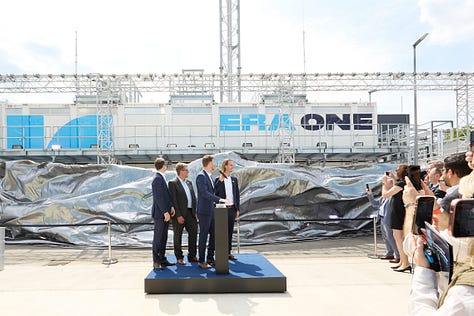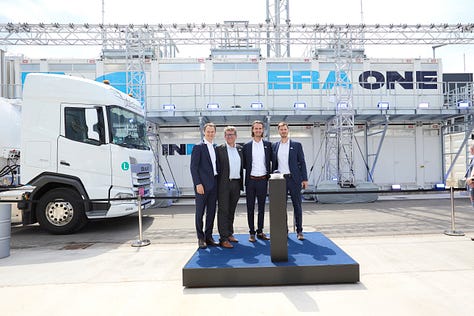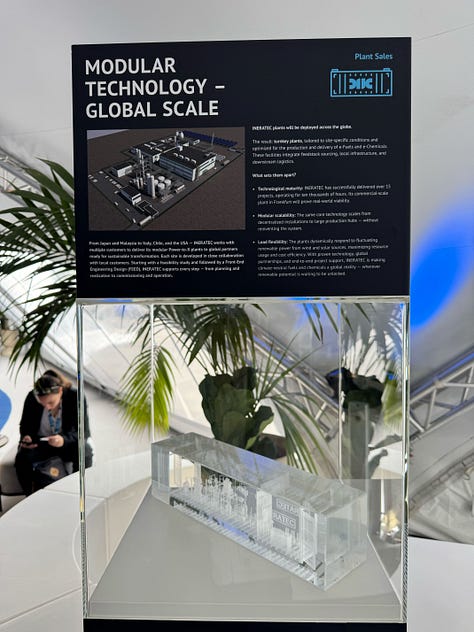Inside Europe’s largest e-fuel facility: INERATEC’s ERA ONE
INERATEC's Frankfurt facility proves commercial-scale synthetic fuels are ready for market, despite unprecedented engineering challenges.
Earlier this week, INERATEC officially inaugurated ERA ONE, Europe's largest e-fuel production plant, marking what CEO Tim Böltken called "a new era of sustainable mobility." Located in Frankfurt-Höchst, the Power-to-Liquid facility will produce up to 2,500 tonnes of carbon-neutral synthetic fuels annually, the first commercial-scale volumes available in Europe.
The milestone represents more than just another industrial opening. Backed by a €70 million financing package from organisations including the European Investment Bank (€40M venture debt) and Breakthrough Energy Catalyst (€30M grant), ERA ONE demonstrates that climate-neutral e-fuels have moved beyond laboratory curiosity to market reality.
"We are replacing fossil molecules with green molecules," Böltken explained at the inauguration ceremony, "and thereby making a decisive contribution to a climate-friendly future."
However, reaching this moment required what INERATEC's head of operations, Paolo Piermartini, described with a striking metaphor during a subsequent on-site panel discussion: "The biggest challenge was starting the aeroplane while the runway is still being built."






Engineering the unprecedented
That metaphor captures the extraordinary complexity INERATEC faced in bringing ERA ONE online.
Unlike typical technology deployments, the company simultaneously had to develop cutting-edge synthesis technology while constructing an entire industrial site and learning to operate it, all while parts of the facility were already producing fuel.
"The challenge is that we're not just technology providers here," Piermartini explained. "We built an entire site, we created a complete location from a parking lot."
The infrastructure challenges proved immediately daunting: the team had to excavate 8 meters deep to prepare the contaminated ground of the former industrial site before any construction could begin.
Christina Braumüller, INERATEC's project manager, who has been with the company since 2016, described the learning curve: "It was the first time we had contact with large engineering companies, with construction companies that had requirements for injuries, all of this was the first time for us as a company."
At just 31 years old, Braumüller has overseen what may be Europe's most complex cleantech project deployment. "It was both personally the biggest project for me, and for the company, the first project of this scale," she explained.
During the project, INERATEC doubled its workforce from 70-80 people to over 140, scaling human resources alongside technical capabilities under her project management.
The technical architecture itself required unprecedented coordination. As plant construction partner Arnd Pannenbecker explained, ERA ONE combines INERATEC's first-of-its-kind synthesis modules with standardised industrial components, compressors, tanks, motors, pumps, and cooling units. "When you see an orchestra, INERATEC sets the tempo and the so-called balance-of-plant must follow this tempo," he said.
This modular approach proved crucial for managing the complexity. The facility uses different-sized units, 1 megawatt modules that were fully developed and 5 megawatt units that are still being refined during construction. "Many milestones had to be handled flexibly," Pannenbecker noted, "and that's certainly something when you have a partnership model like INERATEC chose."
Navigating bureaucracy
Perhaps most remarkably, the team managed this flexible, iterative approach while satisfying Germany's complex permitting requirements.
Braumüller explained how they balanced regulatory certainty with engineering agility: "You have to think ahead about how many missions you'll have per year, how many contact points, and then you have some limitations from the permitting in implementation. But in the big picture, you can make small changes during construction."
The key was establishing the framework early while maintaining room for technical evolution. "The authorities look at the whole system," she said. "You can use a different pump, but you have to have foreseen how your plant will look in broad terms."
Proving the model
ERA ONE's successful operation began several weeks before the official opening. This validates more than just INERATEC's technology. It demonstrates a replicable model for rapid e-fuel deployment across Europe's industrial infrastructure.
The plant sources its feedstocks directly from the Frankfurt-Höchst industrial park: CO2 from a biogas facility that processes waste and hydrogen as a byproduct of chlorine production. This integration produces "drop-in ready" synthetic crude oil processed into sustainable aviation fuel, e-diesel, and other products, requiring no modifications to existing engines or infrastructure.
The modular design that enabled flexible construction also enables rapid scaling. By 2030, INERATEC plans to increase annual production several-fold through additional projects, crucial for meeting regulatory requirements like the ReFuelEU Aviation regulation's binding quotas for sustainable aviation fuels.
"We have a proof of concept," noted Pannenbecker. "This means you can guarantee the product in quantity and quality for the next plant abroad. You need an experienced site partner abroad who builds the surrounding infrastructure, but INERATEC then has rollout-ready components."
As Europe pursues its 2030 and 2050 climate targets, ERA ONE offers a template for building the future while operating in the present, one modular unit at a time.
Disclosure: SimpliFlying attended the ERA ONE plant inauguration as a strategic partner to INERATEC. We’re proud to support their efforts and witness this milestone in scaling e-fuels for aviation.



